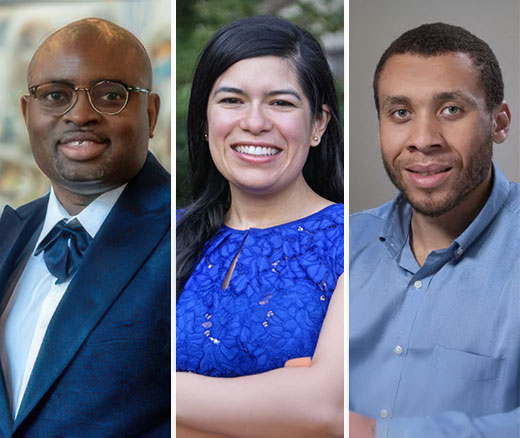
Hospitals Rarely Use Z Codes to Document Patients’ Social Risks
Billing Codes That Flag Food, Job, or Housing Insecurity in Medical Records are Underused for the Sickest Medicare Patients
Blog Post

For many Black families, one of the most critical and often painful conversations they must have with their children is how to safely navigate interactions with police, commonly known as “The Talk.” The disproportionate impact of police violence on Black communities is a well-documented public health crisis, raising urgent questions about how institutions—especially health care—can help mitigate harm. Pediatricians have a unique opportunity to provide anticipatory guidance on this issue. But should they? And if so, how can they engage in these conversations effectively while navigating racial, ethical, and clinical complexities?
This question was at the heart of a recent study by LDI Fellows Emma Edmondson, Maria Christina Herrera, George Dalembert, and colleagues. The research, supported by a Penn LDI Bold Solutions Pilot Grant, sought to characterize how pediatricians approach anticipatory discussions about police interactions with Black adolescents, their families, and caregivers.
Through a series of focus groups with pediatric residents and attending physicians from three academic primary care centers in Philadelphia, the study explored the barriers and facilitators to these conversations. One physician candidly reflected on the challenge of discussing race in a medical setting:
I feel very comfortable listening and being supportive in the way that we are able to be supportive to anyone who’s explaining a circumstance. But because I’m White and don’t have many of those shared experiences, [talking about race and racism is] difficult for me.
The study identified three key themes shaping how physicians navigate these discussions:
The findings underscore the importance of increasing physician diversity and equipping all pediatricians with tools to facilitate these conversations in a patient-centered way.
To learn more about the study’s policy implications and next steps, we spoke with Senior Fellow George Dalembert below.
Dalembert: This research started grounded in clinical practice—two colleagues mentioned a discussion they’d been having about bringing up the topic of safe navigation of police encounters with their Black adolescent male patients. As pediatricians who are not Black, they shared about both the discomfort and the importance of the conversation. We acknowledged that the trainees we work with probably didn’t have training on how to have these types of conversations, though they might be interested in serving as a resource for their patients. As we considered what gives meaning to practice, engaging meaningfully with our patients was a key factor; and this potentially life-saving conversation seemed to be a great example of a meaningful interaction. However, we noted that we might not understand all the factors that come into play as pediatricians consider whether to participate in this type of anticipatory guidance and that we needed to learn more to ground any potential educational intervention.
Dalembert: One of the things that we didn’t want to take for granted in this project was that pediatricians would want to engage in this talk. People could easily have cited the complexity of the social context or logistical factors as a reason to just discourage the integration of this conversation into our anticipatory guidance. But that’s not what we heard. The study participants spoke about the importance of this work and ensuring the necessary guidance and resources to serve our patients effectively. This was something not previously well described in the medical literature.
Dalembert: We intentionally conducted focus groups rather than, for example, individual semi-structured interviews because we thought there would be richness in the conversations that would introduce probes that we could not anticipate or set up as naturally as a group conversation might. We intentionally selected our focus group facilitators to minimize social desirability bias and engaged in purposive sampling to be intentional about representing a broad range of opinions, lived experiences, and recommendations. We recognized that we were recruiting from urban primary care settings and a residency training program where people might intentionally come to practice because their personal missions align with serving underserved populations. Therefore, we wanted to ensure that there was as much diversity of voices in the room as possible to help generate robust discussion and ensure our findings were generalizable.
Dalembert: Pediatricians noted that these conversations were important to have. Successfully motivating them to act on that disposition will benefit from additional incentives. For example, being able to bill for this type of anticipatory guidance or having more time to see patients get into this type of conversation because one isn’t pressured in an unforgiving fee-for-service model might help to give the conversations the space they need to be done ideally. From a pragmatic clinical practice perspective, starting to collate resources to support pediatricians in engaging in the talk and supporting families in navigating their realities will be important to turn these findings into concrete results for our communities.
Dalembert: Any real conversation has two sides engaged. We’ve heard from pediatricians; we need to hear from the families. Understanding adolescent and caregiver perspectives will be critical to informing the development of any guidance and best practices for integrating these conversations into the work pediatricians consider our bread and butter.
The study, “Pediatrician Perspectives on Incorporating Discussion of Police Encounters Into Anticipatory Guidance for Black Youth and Their Caregivers,” was published on January 13, 2025, in JAMA Pediatrics. Authors include Jeffrey M. Eugene, Maria Nelson, Rebecca Neergaard, Emma Edmondson, Sarah Capponi, M. Christina Herrera, Judy A. Shea, Katherine Yun, Nicole Jaffe, Julie Premo, and George Dalembert.


Billing Codes That Flag Food, Job, or Housing Insecurity in Medical Records are Underused for the Sickest Medicare Patients

Experts Say Nursing Ethics Can Help Researchers Confront Federal Disinvestment, Defend Science, and Advance Health Equity

Study Finds Major Gaps in Cardiac Care Behind Bars

Eighth Year of Program That Recruits, Mentors and Develops Junior Faculty for Health Services Research

Chart of the Day: National Study Shows White Patients More Likely Than Black Patients to Get CT and/or Ultrasounds for Abdominal Pain in the Emergency Department

LDI Fellows Uncover Six Key Barriers and Solutions to Achieving Better Hospital Care